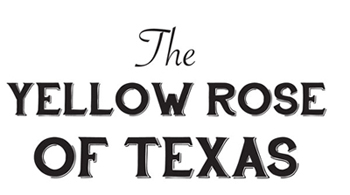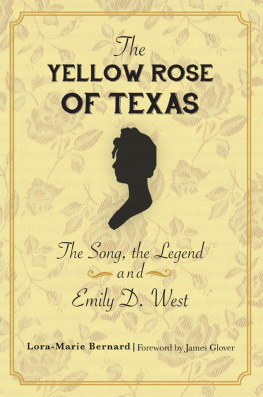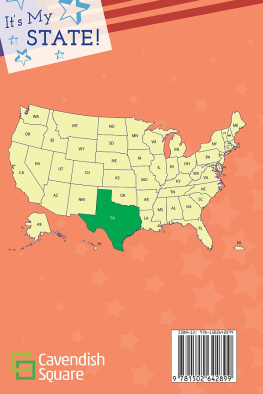


Published by The History Press
Charleston, SC
www.historypress.com
Copyright 2020 by Lora-Marie Bernard
All rights reserved
First published 2019
E-Book edition 2019
ISBN 978.1.43966.883.2
Library of Congress Control Number: 2019951263
Print edition ISBN 978.1.46714.257.1
Notice: The information in this book is true and complete to the best of our knowledge. It is offered without guarantee on the part of the author or The History Press. The author and The History Press disclaim all liability in connection with the use of this book.
All rights reserved. No part of this book may be reproduced or transmitted in any form whatsoever without prior written permission from the publisher except in the case of brief quotations embodied in critical articles and reviews.
Dedicated to Jorie Nissen, Jennifer Parsley and Emily D. West.
The librarian, the historian and the brave ordinary woman we will never really know.
I thank all three of them for enriching my life.
CONTENTS
Foreword
The history of Texas, from earliest exploration up to the present day, is an epic saga composed of some of the most fantastic stories ever told. These stories have made their way into popular culture, patriotic platforms and songs and onto the silver screen. The more incredible tales usually are the ones with the most truth behind them; the underlying facts and conditions often are of more importance than the stories themselves.
The Yellow Rose of Texas is, in the vernacular of its telling, the story of a biracial slave girl captured by an invading Mexican army, conducted to the supreme commanders distinctly striped tent and ravaged by the depraved general. While he takes advantage of her, she returns the favor by distracting him from his duty and contributing to his ultimate downfall. The story of Emily Morgan, the property of Colonel James Morgan, has been taught in some form to almost every Texas school child since the 1930s. The Yellow Rose story is exciting, racy, salacious and largely an apparent work of fiction.
Our tale first emerges from the pages of William Bollaerts journals, penned during his Texas visit of 184244. Bollaert was an apt observer of customs, geography, politics and history. Prior to visiting Texas, he had traveled extensively throughout South America and Europe, publishing several works on a variety of topics, mostly for the British societies of which he was a member. Ostensibly, Bollaert had intended to publish his notes in manuscript formhe did begin work on such a manuscript at some point but was distracted in other ventures, including the raising of a family.
Bollaert asserts that his story springs from a true and trusty gentleman, well placed in Texas politics, who was present at the Battle of San Jacinto. Most scholars who have researched Bollaerts papers agree that the source can be none other than then-president Sam Houston. Upon publication of Bollaerts work in 1956, under the title Bollaerts Texas, the Yellow Rose story was omitted as trivial and without substantial foundation. Nevertheless, the story had leaked out at least two decades earlier through scholars and researchers who had been mining the papers for information.
Had the tale made its appearance immediately following the 1836 battle, it would surely have been immensely popular, much as it was during the Texas Centennial of 1936.
In and of itself, the Yellow Rose story is a wonderful little tale comparable to something out of The Arabian Nights. From a standpoint of veracity, it has some issues. First, it is a single-source account that appeared several years after the events were to have taken place. The same problem arises when investigating Travis Line in the Sand and the story of Francis Rose making his escape from the Alamo. These last two tales were published in an 1890s newspaper, as recounted by William Zuber, a veteran of the Texas Revolution. Some academics argue that his account is a ploy for recognition born of self-aggrandizement. Zuber didnt actually see the events take place; he wasnt there. Similarly, Houston was nowhere near Santa Annas tent while the general was present and could not have seen anything relative to the Yellow Rose story, though he may have heard it from his men. He certainly would have been aware of the legal battle that followedwhich is very relevant to the story and is covered in Ms. Bernards present work. It is a bit odd that no one else recorded the story early on. Perhaps it was repeated to Bollaert to impress or entertain the visiting Englishman with no view to the details being exactly as they were presented.
The other problem with the story is that it makes some basic assumptions that have generally been accepted by the public and scholars alike. We are told that Emily is biracial and must have been a slave, as free blacks were very uncommon in Texas at that time. Indeed, the noble Texians who rescued her believed her to be a slave and intended to auction her along with Santa Annas other possessions. This goes hand in hand with the presumptive reasoning behind her capture: that she was a slave and was therefore contraband, or illegal property, under the laws of Mexico because Mexico had outlawed the practice some years earlier. The third major assumption is that poor, promiscuous Emily had been entertaining the Mexican general in his tent even by schoolchildren, this was interpreted in a salacious manner.
The Yellow Rose story actually reveals a great deal about race and race culture in the United States and England in the 1840s and how it had changed in Texas from the mid-1830s to the time Houston related his tale to Bollaert.
Mexican Texas in the 1830s was not a liberal utopia; several attempts by abolitionist societies to establish colonies in Texas were thwartedone by Stephen Austin himself. It was, however, a mixed population, much as that of Mexico. The notable exception was that, aside from Nacogdoches and the San AntonioVictoria area, very few Hispanic people made their home north of the Nueces River. With free people of color, it is a different story.
The term free people of color is a period term often denoted as FPOC on documents of the era and refers to blacks, mulattos or pretty much any admixture of Negro and white, Indian or Hispanic. While the number of free people of color in pre-revolution Texas is not staggering, it is far greater than what most of us have been led to believe. In other words, just because Emily was a mulatto does not indicate that she was a slave; she could just as well have been a free black.
Mexico never outlawed slavery while Texas was part of the republic. Plantations in the Yucatan, mines and ranches in Jalisco and the textile mills and cotton plantations of Puebla, near Mexico City, boasted large numbers of black and Indian slaves. The state of Coahuila, of which Texas was part, did make slavery illegal in 1830 but rescinded the law within six months of its passage; slavery was too important to the economy. The seizing of Emily must be seen in a different light. Rather than contraband, she was taken (for she says that she was taken) as something of value. The Mexicans obviously did not realize she may have been free. Santa Annas officers, in the journals and diaries they left behind, tell of the treasures that were plundered from the Texas countryside. General Urrea, who occupied Columbia and Brazoria while Santa Anna was being entertained at San Jacinto, reportedly returned to Matamoros with three thousand head of cattle that he acquired during the Texas Campaign. Emily apparently was taken either to be a slave for her captors or to be sold as a prize. Whether she was free or not prior to her capture really would not matter much.
Next page









